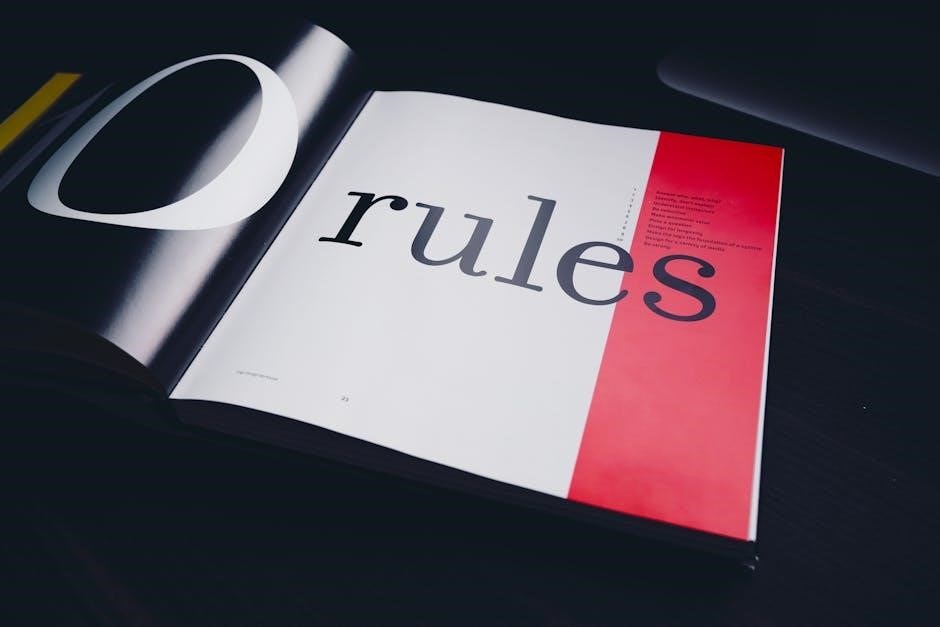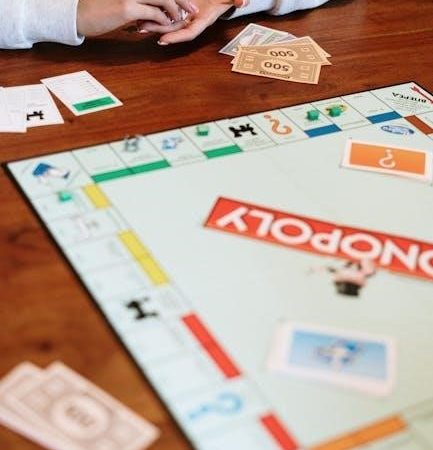Checkers, or Draughts, is a classic two-player board game played on a checkered board. Players aim to capture opponent pieces or block them entirely. Its global popularity endures with standard rules and international variations.
Historical Overview of Checkers
Checkers, also known as Draughts, traces its origins to ancient Mesopotamia around 1400 BCE with a game called Alquerque. The modern version emerged in 12th-century France as “Ferses,” evolving into “Dames” by the 16th century. It spread to England, where it became known as Draughts, and was introduced to America by English colonists. The name “Checkers” was adopted in the U.S., and standardized rules were established in the 19th century. Today, it remains a beloved game worldwide, with variations like International Draughts and Polish Draughts reflecting its diverse history.
Basic Setup of the Checkers Board
The Checkers board consists of an 8×8 grid of alternating black and white squares. Players begin with 12 pieces each, placed on the dark squares of the first three rows closest to them. The board is positioned so that each player has a light square on their left and right corners. Pieces are only moved on the dark squares, and the setup ensures symmetry, with each player’s pieces mirroring the opponent’s across the board. This arrangement creates a balanced starting point for the game.

Rules of Movement in Checkers
Movement in Checkers is diagonal, with pieces moving forward to empty squares. Kings can move both ways, and captures are made by jumping over opponents’ pieces.
Forward Diagonal Movement
In Checkers, pieces move diagonally forward to adjacent squares. Regular pieces can only move toward the opponent’s side, while Kings can move in both directions. Capturing occurs by jumping over an opponent’s piece to an empty square beyond it. Multiple jumps are allowed in a single turn if opportunities arise. Movement is restricted to dark squares, and pieces cannot move backward unless they are Kings. This rule ensures strategic gameplay and balanced opportunities for both players.
Kings and Their Movement Capabilities
A King, denoted by a crown or double piece, gains enhanced movement capabilities. Unlike regular pieces, Kings can move diagonally in both forward and backward directions. This allows Kings to capture opponent pieces in any direction, significantly increasing their strategic value. Kings are created when a piece reaches the opposite end of the board during forward movement. Their ability to move freely across the board makes them powerful assets in controlling the game and executing advanced tactics.
Capturing Opponent’s Pieces
Capturing opponent’s pieces is a key strategy in checkers. A piece can capture an opponent’s piece by jumping diagonally over it to an empty square. This can occur in any direction, including backward for Kings. Multiple captures in a single turn are allowed if opportunities arise. Capturing is mandatory if possible, ensuring players must act to seize advantages. This rule adds complexity and tactical depth, making capture plays pivotal in securing victories and controlling the board effectively during gameplay.
Objective of the Game
The objective of checkers is to capture all of your opponent’s pieces or block them so they cannot move. Players win by achieving either condition.
Winning Conditions
In checkers, a player wins by capturing all of their opponent’s pieces or blocking them so they cannot make a valid move. Capturing occurs by jumping over an opponent’s piece to an empty square beyond. Multiple jumps in a single turn are allowed if opportunities arise. The game also ends if a player’s pieces are completely blocked and cannot move. Achieving either of these conditions results in an immediate victory, concluding the game.
Draw Conditions in Checkers
A draw occurs in checkers when both players agree to end the game without a winner. This can happen if the remaining pieces on the board cannot force a win for either side. Additionally, if the same position recurs three times, the game is declared a draw; Another draw condition is if no pieces are captured and no king is made within a specified number of moves, typically forty, as per official rules. These conditions ensure the game concludes fairly without unnecessary prolongation.

Special Rules and Concepts
Special rules in checkers include forced captures and multiple jumps, enhancing gameplay complexity. These concepts require strategic thinking and adherence to specific regulations, ensuring dynamic matches.
Forced Captures
Forced captures are a mandatory rule in checkers, requiring a player to capture an opponent’s piece if possible. This rule adds complexity and strategic depth, ensuring players must act when opportunities arise. If multiple capture options exist, the player can choose, but failing to capture results in losing the turn. Forced captures are unique to checkers, distinguishing it from other board games and emphasizing tactical play. This rule ensures dynamic and competitive gameplay, making it a cornerstone of checkers strategy.
Multiple Jumps in a Single Turn
In checkers, a player can make multiple jumps in one turn if they have the opportunity to capture several opponent pieces consecutively. After a successful capture, the same piece must continue jumping if another capture is possible. This rule allows for strategic removal of multiple opponent pieces in a single turn, enhancing the game’s dynamic and tactical depth. Multiple jumps can occur in any direction and are a key element in advanced gameplay, requiring careful planning and foresight to maximize their effectiveness.

Strategies for Different Phases of the Game
Strategies vary across game phases: control the center early, use midgame tactics to create advantages, and plan endgame moves carefully to secure wins or draws.
Opening Strategies
Opening strategies in checkers focus on controlling the center and creating mobility. Players often place their checkers on central squares to dominate key positions early. Maintaining flexibility is crucial to adapt to opponents’ moves. A common tactic is to advance checkers to create potential for future captures or king promotions. Experienced players also aim to force early captures, disrupting their opponent’s setup. Proper opening moves set the foundation for a strong midgame position, making them essential for long-term success in checkers.
Midgame Tactics
Midgame tactics in checkers involve building a strong prime and creating “anchors” to secure your position. Players focus on forcing captures to reduce opponents’ pieces while preserving their own. Kings are highly valued for their ability to move freely and control the board. Strategic sacrifices may be made to open lines for future captures. Controlling key squares and maintaining mobility are critical to outmaneuvering your opponent. Effective midgame play sets the stage for a successful endgame, emphasizing both offensive and defensive strategies to gain a decisive advantage.
Endgame Techniques
In the endgame, players focus on maximizing their advantage by strategically positioning kings to control key squares. Building a strong “prime” and creating barriers to limit opponents’ movement are crucial. Kings can block opponents while advancing your own pieces. Forcing opponents into positions with no legal moves often leads to victory. Timing captures carefully and maintaining mobility are essential. Endgame techniques emphasize precise calculation and leveraging kings’ versatility to secure wins or force draws, showcasing mastery of checkers’ strategic depth.

Variations of Checkers
Checkers has several international variations, including English, Polish, and Ghanaian Draughts, each with unique rules and board sizes, offering diverse strategic experiences for players worldwide.
International Draughts
International Draughts is played on a 10×10 or 12×12 board, offering a larger playing field than standard checkers. It is widely popular in Europe and often used in competitive tournaments. The game starts with 20 pieces per player, placed on the dark squares of the first three rows. Movement is diagonal, and kings can move backward, adding strategic depth. Capturing is mandatory, and multiple jumps in a single turn are allowed, making it a dynamic and challenging variation. Its complexity attracts experienced players worldwide, governed by the World Draughts Federation (WMDF) rules.
Polish Draughts
Polish Draughts, a popular variation in Western Europe, is played on a 10×10 board with 20 pieces per player. The setup involves placing pieces on the first three rows of dark squares. Movement is diagonal, and kings can move both forward and backward. Capturing is mandatory, and players can make multiple jumps in a single turn. Governed by international rules, Polish Draughts emphasizes strategic thinking and is a favorite in competitive play, offering depth and complexity for experienced players.
Ghanaian Draughts (Damii)
Ghanaian Draughts, known as Damii, is a traditional board game played widely in Ghana. Played on a 12×12 board with 24 pieces per player, Damii follows rules similar to international draughts. Pieces move diagonally forward, capturing opponents by jumping over them. Multiple jumps in a single turn are allowed, and captures are mandatory. Damii holds cultural significance, often played in communities and social gatherings, showcasing its importance in Ghanaian social life.
Kings in Checkers
Kings in Checkers are pieces that have reached the opposite end of the board, gaining enhanced mobility by moving both forward and backward diagonally, adding strategic depth.
Becoming a King
A piece becomes a king by reaching the opposite end of the board, either through a capture or a regular move. Upon reaching the final row, it is crowned, often with another checker placed on top. Kings gain the ability to move backward and forward diagonally, significantly enhancing their strategic value. This promotion is a key objective, as kings can control more of the board and influence the game’s outcome decisively. The coronation is visually indicated, ensuring clarity during gameplay.
Power of Kings in Gameplay
Kings possess the ability to move both forward and backward diagonally, granting them superior control over the board. This dual movement capability allows kings to block opponents, capture pieces in either direction, and dominate key positions. Their enhanced mobility makes them invaluable for both offensive and defensive strategies, often determining the game’s outcome. Kings are crucial for achieving checkmate or forcing a draw, as their versatility enables them to adapt to various game scenarios effectively.
Checkers remains a timeless, universally enjoyed game, offering strategic depth and simplicity, ensuring its enduring popularity across generations and cultures worldwide.
Why Checkers Remains Popular
Checkers remains popular due to its simplicity and strategic depth, appealing to players of all ages and skill levels. Its classic design ensures accessibility, while variations like International Draughts keep gameplay fresh. The standardized rules and competitive nature foster a sense of community, making it a timeless favorite for both casual and serious players worldwide.
Future of Checkers and Its Variants
Checkers and its variants are expected to thrive as digital platforms and AI tools introduce the game to new generations. The rise of online tournaments and competitive play ensures its relevance in modern gaming. Variants like International Draughts and Damii continue to evolve, adapting to cultural and technological advancements. With structured rules and global competitions, Checkers remains a timeless classic, ensuring its enduring appeal and growth in the years to come.
